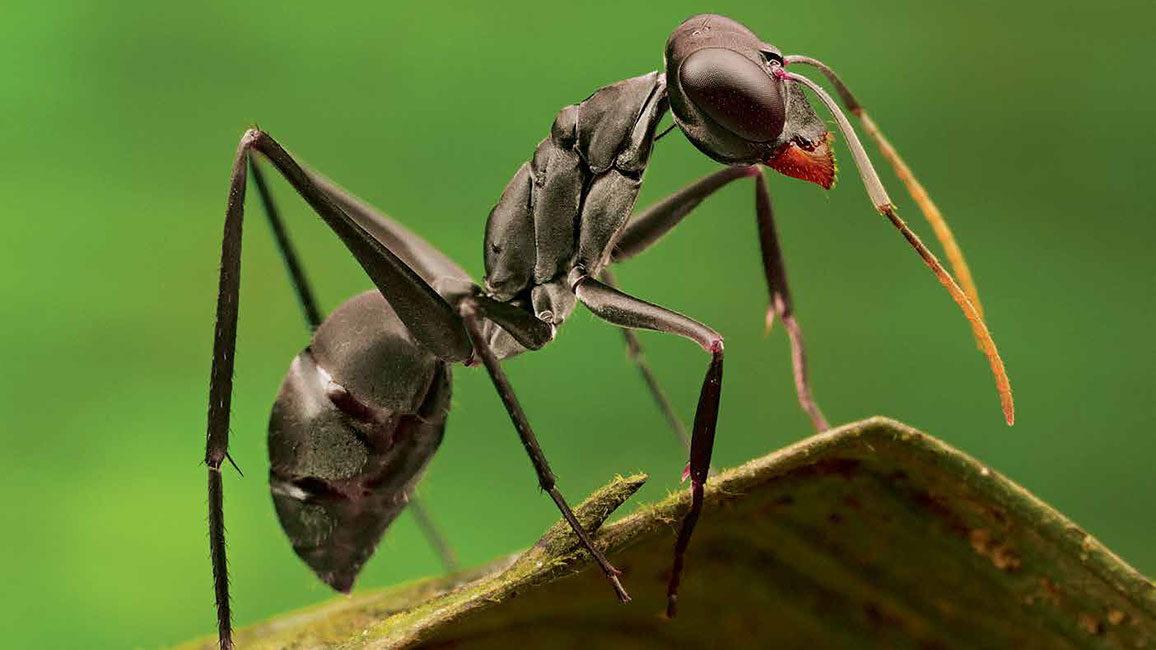
Ants Rule!
By Ellen LambethAnts are tiny-but-tough insects that show up for work almost anytime, anywhere!
You might think an ant is just a common, everyday creepy crawly. What you might not know is that there are about 12,000 different species of ants that scientists already know about. And there could be that many more still waiting to be discovered!
Ants live all over the globe except in Antarctica and on certain far-off islands. More kinds live in tropical places than anywhere else. But no matter where they live, you can be sure they are hard at work—doing what ants do. Find out what that is on the following pages.
TRAPPED IN TIME
Ants have been around for about 120 million years. You can see some of these long-ago ants in fossils. Sometimes an ant would accidentally crawl or fly into some oozing tree sap and get stuck. (Ants have wings only when it’s time to fly off and find mates.) The hunk of sap with the ant inside slowly hardens. Eventually it turns into this golden, glassy fossil called amber.
THE SECRET LIVES OF ANTS
Most insects are solitary, which means they live alone. But, like some of their bee and wasp relatives, ants are social insects. That means they live and work together in groups called colonies. A single colony may have anywhere from dozens to millions of members!
ALL IN THE FAMILY
All the ants in a colony have special jobs to do. The large one in this fire ant colony is the queen. Her job is to lay eggs. The smaller ants are workers. They clean and take care of the queen, the eggs, and the young ants. They also protect the colony’s nest and constantly keep it clean and repaired.
ANTS IN PLANTS
Different kinds of ants build their nests in different places. You’re probably used to seeing ants that burrow underground. But other kinds may tunnel under tree bark or inside branches, flowers, or seeds such as acorns. These acacia ants make their home inside the swollen base of a thorn on an acacia (uh-KAY-shuh) tree. For food, they eat the sweet nectar that oozes from the tree’s leaves.
ALL SEWED UP
This group of weaver ants lines up at the edge of a leaf, grabs another leaf edge, pulls the edges together, and holds them in place. Another weaver will grab a larva (young ant) that produces silk. Holding and moving the larva back and forth, the weaver uses a thread of sticky silk to “sew” the leaf edges in place to make a nest.
CHIT-CHAT
Ants “talk” to each other with scents called pheromones (FAIR-uh-mohnz). They use their antennas to smell the scents given off by other ants. They also communicate by touching each other with their antennas. The big queen carpenter ant on the right taps the worker ant with her antennas to say she’s hungry. The worker ant then passes food to her, mouth to mouth.
ON GUARD
If anything threatens a colony, ants won’t take it lying down! Swarms of them come out in force to bite or sting their enemies. Many kinds of ants have powerful jaws or can inject painful chemicals through stingers on their back ends. Some even shoot out burning, irritating chemicals such as formic acid from their rear ends, as these wood ants are doing.
FAMILY FEAST
It takes a lot of work and cooperation to feed a colony. But ants are up to the task! Here are some of the ways they do it.
HUNTING
You don’t want to be in the way when thousands and thousands of army ants are on a raid. With sharp, powerful jaws, they can kill, chop up, and eat or carry away just about any creature caught in their path. The workers form a quick-moving swarm. Meanwhile, larger soldiers guard them from enemies along the edges.
GARDENING
Like army ants, leafcutter ants march across the forest in long columns. But they’re not hunting prey. Instead, they’re gathering bits of leaves and carrying them back to the colony. They won’t eat the leaf bits, though. They use them to grow fungus in underground “farms.” The fungus is then harvested to feed the whole colony.
HERDING
Some kinds of ants—such as these red ants—keep insects called aphids as “livestock.” They take care of the aphids and keep them safe from aphid-eaters. Why? Because the aphids poop out sweet droplets called honeydew, left over from juices they suck out of plants. Ants may even rub their antennas on the aphids to “milk” them for this treat.
STORING
You never know when food might be in short supply. So it’s always good to put some away for later. And honeypot ants have a strange way of doing that. Some of the ants fill up with liquid food and hang upside down from the ceiling of their nest. When food is needed—such as during the dry season—they spit some up for workers to share with the rest of the colony.
ANT-EATERS
There’s no shortage of ant-eating animals, including other insects, lizards, and birds. Some animals are even specially built for it. The baby-toting giant anteater at right, for example, has a great sense of smell for finding ants, strong claws for digging into their nests, a tube-like snout for poking down in there, and a long and sticky tongue for slurping up the ants. Good thing there are plenty of ants in the world to go around!
“Ants Rule!” originally appeared in the May 2017 issue of Ranger Rick magazine.



















